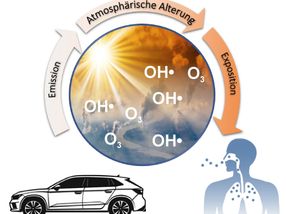Towards more effective therapies to fight breast cancer
breast cancer is one of the most common cancers in women in Italy and in the world. Today, however, it seems possible to design more selective and effective drugs through numerical simulations. This is what has been revealed by research carried out by the "Istituto Officina dei Materiali" (IOM) of the Italian National Research Council (CNR) in Trieste and the International School for Advances Studies (SISSA), in collaboration with the Bellinzona Institute for Research in Biomedicine and the University of Italian Switzerland. This study analyzed in detail the mechanisms activating an important pharmacological target involved in female hormone synthesis, exceeding the limits of experimental approaches. This research, funded by AIRC - the Italian Association for cancer Research, has shown that molecules of different shapes and sizes follow the same pathways within the protein to access the active site i.e. the heart of the protein where female hormones are synthesized.

The image represents the human aromatase (on the right side), an enzyme involved in hormone biosynthesis, with its in/out ligand channels (in yellow and magenta) travelled by letrozole, a last generation inhibitor clinically used against breast cancer (left side) and androstenedione (on the bottom right side), one of the molecules that aromatase converts to estrogens.
Alessandra Magistrato and Lorenzo Casalino, CNR-IOM and SISSA, Trieste, Italy
Cytochromes P450 are enzymes that play a key role in the metabolism of different hormones and drugs. In particular, they are important pharmacological targets for treating breast and prostate cancer» explains Alessandra Magistrato, CNR-IOM / SISSA researcher and first co-author of the work together with Jacopo Sgrignani of the Bellinzona Institute for Research in Biomedicine. We have known for a long time that these enzymes are characterized by a hidden active site, which can be reached through several of grueling access channels whose real function is not yet known. We chose aromatase as a prototype of the cytochrome P450 family and compared the access paths of two molecules differing in shape, size and hydrophobicity - i.e. the tendency to interact with water».
Aromatase is an enzyme responsible for the synthesis of female sex hormones, whose excessive production is among the causes of breast cancer development. In the study, led by Alessandra Magistrato of CNR-IOM/SISSA and Andrea Cavalli of the Bellinzona Institute for Research in Biomedicine and carried out in collaboration with Rolf Krause of the University of Italian Switzerland, the researchers compared a last-generation anti breast cancer drug, an aromatase inhibitor, and a hormone on which the enzyme acts.
Through classical molecular dynamics simulations, which allow us to study the evolution of the processes at an atomistic level, we were able to identify and characterize, from an energetic point of view, the preferential access paths of the two molecules to reach the enzyme catalytic site. Surprisingly we identified the same two channels in both cases, regardless of the different shape, size or hydrophobicity of the two molecules studied. Moreover, the similarity between different cytochromes P450 at the critical points suggests that this feature may be common to the entire enzymatic family».
These are results which cannot be directly observed experimentally, but which are crucial for developing more selective and effective drugs», concludes the researcher. The study is in fact part of a "My First AIRC" project, that was financed to Alessandra Magistrato by AIRC - the Italian Association for Cancer Research for designing, synthesizing and testing new anticancer drugs to fight breast cancer.
Original publication
Original publication
Alessandra Magistrato, Jacopo Sgrignani, Rolf Krause, and Andrea Cavalli; "Single or Multiple Access Channels to the CYP450s Active Site? An Answer from Free Energy Simulations of the Human Aromatase Enzyme"; The Journal of Physical Chemistry Letters; 2017
Topics
Organizations
Other news from the department science

Get the life science industry in your inbox
By submitting this form you agree that LUMITOS AG will send you the newsletter(s) selected above by email. Your data will not be passed on to third parties. Your data will be stored and processed in accordance with our data protection regulations. LUMITOS may contact you by email for the purpose of advertising or market and opinion surveys. You can revoke your consent at any time without giving reasons to LUMITOS AG, Ernst-Augustin-Str. 2, 12489 Berlin, Germany or by e-mail at revoke@lumitos.com with effect for the future. In addition, each email contains a link to unsubscribe from the corresponding newsletter.























































